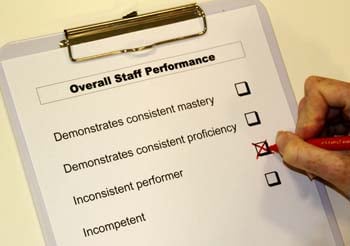
We've all heard the term "Death by PowerPoint" and the majority of us have been scarred by poor presentations and classroom learning techniques, at some point in our...
A few months ago a good friend of mine had a business that went into administration. It was only three years ago we celebrated over lunch that he had 35 employees and impressive revenue and profit. Then, the perfect storm happened. Poor strategic execution and decreased sales saw his business decimated in a tough industry. Underlying all of the obvious issues was a CFO who fraudulently stole $1 million dollars. Together, it brought the company down and it not longer exists in its previous form.
One of the legal requirements of a CEO or business owner and their board is to effectively govern their organisation. They need to set the ethics, the values and consider how to put the right controls in place to ensure the organisation is not run negligently. The result is a board that monitors management and relies on compliance, risk and internal audit committees.
While my friend certainly needed a good board to steer his organisation (he didn’t have one) and put the right financial controls in place, too much compliance can stifle an organisation. When a company is run with strict policies and procedures, a command and control approach often leads to decreased speed and increased costs. Employees who have to go through cumbersome approval processes to purchase much-needed office provisions or even business services lose their energy and passion for their jobs.
Ironically, increased compliance often leads to fraudulent behaviour, as employees don’t feel trusted they are more likely to “pay back” the company by stealing things here and there. After all, when there is no trust it almost becomes a self-fulfilling prophecy that employees are more likely to steal.
This is a big issue. In Australia, the estimated cost of fraud in Australia is $8.5 billion annually and the average fraud in Australia and New Zealand amounts to $3 million (Australian Institute of Criminology). Sixty percent (60%) of fraud cases take over 3 years to detect (Warfield & Associates) with 61% of fraud cases resulting in no recovery (KPMG). Even more surprising is that 50% of Australian businesses experience economic crime (Ernst and Young).
At the heart of governance lies the perspective that people are self-interested and willing to take actions to further their own interest at the expense of the organisation. Research shows that the majority of people will steal if it’s easy to do and there’s relatively little chance of being caught. Of course, once an employee starts stealing and they get away with it, it’s more likely to become habitual.
To prevent financial, safety and operational mismanagement companies implement controls such as policies, procedures, audits and performance management.
Unfortunately, most top-down hierarchical structures tend to originate from the mindset that because a small minority can’t be trusted, the larger majority can’t be trusted either. Control and trust often become confused with the belief that if we trust people, we’re not in control.
As a result, the most common response to trust violations is to throw more rules at the problem – which mostly punishes the many because of the actions of the few.
In the area of safety, the outcome is huge, boring policy manuals that speak to employees as if they’re stupid and about to hurt themselves and others or damage expensive equipment. In my previous role improving safety induction training programs for large companies, I would have to force myself to read these cumbersome tomes absolutely gob-smacked that anyone would even want to work for a company that right from the start treated employees like morons. In fact, so disappointed was I with the language of most induction training, I wrote the book Transform your Safety Communication, in order to help safety professionals write friendly, respectful information on safety.
Research has found that increasing autonomy in a job, increases job satisfaction. People never like being told that they have to do something. Forcing people to do a task a certain way, never works well long term. Good leaders communicate in a way that enables employees to believe that they decided they had to follow certain rules to protect themselves and their mates.
What most leaders don’t understand is that the unfortunate side-effect of strict compliance is a lack of trust throughout the organisation (including leadership). Employees will never trust a leader who zealously micromanages and controls others. Low-trust organisations have lower revenue than high-trust organisations, they are also less likely to innovate, collaborate and have satisfied employees and customers.
It might seem counter-intuitive but creating a high-trust organisation with relatively little compliance produces the best results. In a high-trust environment, the culture becomes self-regulating and reinforcing of trust, weeding out perpetrators. It becomes a much more effective form of “control” than additional rules and policies.
Charles Munger, the Vice President of Berkshire Hathaway and business partner to Warren Buffett is a vocal believer in the power of creating high trust companies. Munger contends that it’s unreasonable to expect governance systems to work for all companies as a”one solution fits all” is not the best option for diverse companies from hospitals right through to movie studios.
Berkshire Hathaway operates with fewer rather than more controls. Currently, Warren Buffet operates with 76 direct reports and 70,000 employees globally. Both Munger and Buffett believe that a trust-based system allows individuals to operate without extensive control procedures and therefore, avoid the time and cost of having their own actions monitored and having to monitor the actions of others. The result is a highly efficient trust-based system. It only works if self-interested behaviour among employees and executives is low. Munger says:
“Good character is very efficient. If you can trust people, your system can be way simpler. There’s enormous efficiency in good character and dis-efficiency in bad character.”
According to Verne Harnish in the book, “Scaling Up,” creating a strong culture driven by a handful of rules makes leading people much easier, reduces the need for stacks of policies and procedures, gives everyone a foundation from which to make tough decisions, and generally brings simplicity and clarity to many of the ‘people’ systems within a firm.
As Jeff Jarvis said in What would Google do?:
“There is an inverse correlation between control and trust. The highest form of control actually comes from having a high-trust culture, not from excessive rules. When we start with the belief that most people can be trusted, we have options we didn’t have before.”
Of course, companies need to ensure that their employees are obeying the law. While it’s still important that you train employees to be aware of legal requirements at the heart of it all, balance is required.
Compliance shouldn’t remove people’s ability to think for themselves and have autonomy in their jobs. Too many rules takes away people’s capacity to think through issues. Having a few clear guidelines makes people smarter, as they are more accountable for their actions and they’re empowered to think. When creating a handful of company guidelines, it’s important to develop good thinking skills among your employees that will support ethical judgement and behaviour. This means considering questions such as:
“How do we want our employees to think?”
“How well are we living our legacy?”
“What are the biggest risks to our business?”
“What do we want to be remembered for?”
“What are the right behaviours we need to reach our goals.”
As Sam Stern, an analyst at Forrester Research says:
“You want to be prescriptive and specific, but leave employees with enough autonomy and power to decide how to react in the moment. Workers should have guidelines and suggestions for handling a variety of customer issues–they shouldn’t be left to improvise.”
The amount of rules and regulations depends upon your environment. For some industries and organisations, strict policies and procedures can be appropriate depending upon the degree of risk involved (eg: underground mining). And having no policies is even worse. When you consider that people will steal, under the right conditions, slack controls are asking for trouble.
Starting with high trust is the only way for leaders to create a high-trust environment. It’s a common estimate that 3% of your workforce will try and cheat. But rather than create rules to stop them, create rules for the 97% that want to do the right thing. The end result is that the cheaters will become highly visible and ejected out of the organisation like a virus.
Designing rules to stop the few, impact the many. The outcome is painfully slow execution through excessive bureaucracy, unnecessary redundancy and an unhappy workforce that are less likely to collaborate, innovate and treat customers well.
As for my friend whose business went into administration, he was too trusting and didn’t have enough controls in place. He needed to have thought through his biggest business risks, put in the right controls, hire the right people and train them all effectively in the right behaviours. The result would have been a watertight system that thwarted any attempts to cheat, while providing him with the right checks and balances to alert him when something was amiss. While we must always aim to trust, we must still verify. As in all things in life, balance is always necessary.

We've all heard the term "Death by PowerPoint" and the majority of us have been scarred by poor presentations and classroom learning techniques, at some point in our...

It goes without saying that staff training is incredibly important for continual company improvement.